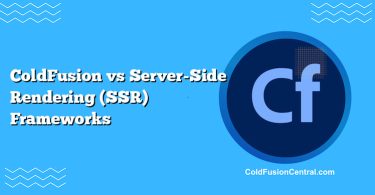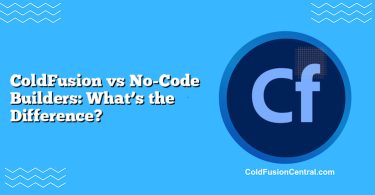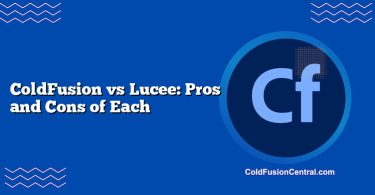Definitions
- ColdFusion: Adobe ColdFusion is a commercial, JVM-based application server and rapid application development platform for building web applications using CFML (ColdFusion Markup Language). It typically runs on dedicated servers or containers, supports session state, long-running requests, and tight integration with databases, caching, and scheduled tasks.
- AWS Lambda: AWS Lambda is a serverless, event-driven compute service that runs code in response to triggers (HTTP requests, S3 events, messages, schedules) without managing servers. You pay per request and execution time, and it automatically scales by running functions in parallel as needed.
Overview
What problem does each solve?
- ColdFusion focuses on building full-featured web apps with minimal boilerplate, offering a batteries-included framework for form handling, database access, PDF generation, scheduled jobs, and enterprise integration. It favors a stateful, server-centric architecture.
- AWS Lambda targets microservices and event-driven workloads where you want automatic scaling, fine-grained deployment units (functions), and pay-per-use economics. It is by default stateless and ephemeral, encouraging cloud-native design.
Key Features
ColdFusion: Key Features
- CFML language with both tag-based and script syntax
- Built-in components: caching, session/state management, ORM (Hibernate), task scheduling, PDF/image manipulation, mail, REST services
- Enterprise connectors: JDBC, LDAP/AD, Exchange/SMTP, Solr (depending on version/edition)
- Runs on Windows and Linux; Docker images available
- Rich admin console, centralized configuration, and logging
- Integrates with application servers, web servers (IIS/Apache), load balancers
AWS Lambda: Key Features
- Event-driven triggers: API Gateway, ALB, S3, SQS, SNS, Kinesis, EventBridge, CloudWatch Events, IoT, DynamoDB streams
- Automatic scaling, no server management
- Millisecond billing, provisioned and on-demand concurrency, and provisioned concurrency for warm starts
- Wide language/runtime support: Node.js, Python, Java, .NET, Go, Ruby, custom runtimes
- Deep AWS ecosystem integration: IAM, VPC, CloudWatch, X-Ray, Step Functions, Secrets Manager, RDS Proxy
- Observability hooks and versioning/aliases for deployments
Performance
Latency and Throughput
- ColdFusion
- Strengths: Low, predictable latency for warm, always-on servers. Good for high-throughput HTTP traffic when the instance is right-sized and tuned (JVM, connection pooling, caching).
- Constraints: Throughput bounded by server resources. Horizontal scaling requires load balancers and more instances.
- AWS Lambda
- Strengths: Near-infinite parallelism per region (subject to concurrency quotas). Excellent for spiky workloads and parallelizable tasks.
- Constraints: Potential cold starts, especially for JVM/.NET functions or when connecting to VPC resources. Mitigations include provisioned concurrency, SnapStart for Java, and keeping functions lightweight.
Cold Starts and Long-Running Tasks
- ColdFusion: The server is long-lived; requests don’t “cold start.” Ideal for long-running requests, reports, and workflows.
- AWS Lambda: Functions are short-lived by design (max 15 minutes). Cold starts can add 100–1000+ ms depending on language and VPC configuration. Not ideal for tasks exceeding 15 minutes unless orchestrated (Step Functions, AWS Batch, Fargate).
Scalability and Availability
- ColdFusion
- Scale-up: Allocate more CPU/RAM to VMs or containers.
- Scale-out: Add more nodes behind a load balancer; share session state via sticky sessions, distributed cache, or database persistence.
- Availability: Achieved via multi-node clusters, health checks, zero-downtime deployments. You manage capacity planning and failover.
- AWS Lambda
- Horizontal scaling is automatic; each request can invoke a new function instance.
- Concurrency controls prevent overload of downstream systems; reserved concurrency and throttling protect dependencies.
- Multi-AZ resilience is built-in; regional failover patterns are straightforward with Route 53, multi-region deployments, or Step Functions.
Security and Compliance
- ColdFusion
- Security is your responsibility: OS hardening, patching CF server, WAF, TLS terminations, and network boundaries.
- CF Administrator security, sandboxing, and secure profile help reduce attack surface.
- Compliance depends on your hosting environment and operational controls.
- AWS Lambda
- Fine-grained access control via IAM roles per function.
- Encryption at rest and in transit, secrets in AWS Secrets Manager/SSM.
- VPC integration for private subnets and controlled egress. Broad compliance coverage leveraged from AWS (SOC, ISO, PCI, HIPAA with BAA), but application-level responsibilities remain yours.
Developer Experience and Productivity
Languages and Tooling
- ColdFusion
- CFML emphasizes rapid development with minimal boilerplate. Built-ins like cfquery, cfmail, cfhttp speed delivery.
- Adobe tooling (ColdFusion Builder), popular IDEs with CFML plugins, and frameworks like ColdBox/Framework One.
- Alternative open-source engine: Lucee (CFML), often used with modern CI/CD and containers.
- AWS Lambda
- Choose mainstream languages. Strong tooling with SAM/Serverless Framework/CDK/Terraform and local emulators.
- Encourages small, single-responsibility functions, decoupled by event streams and queues.
- Requires packaging dependencies and adopting event-driven patterns.
Local Development and Debugging
- ColdFusion: Traditional server-style debugging with logs, templates, and breakpoints in IDEs. Local replication of prod is straightforward with Docker or a local server.
- AWS Lambda: Local simulation via SAM CLI or Serverless Framework. Debugging often relies on CloudWatch logs, X-Ray traces, and replaying events. Requires more cloud-native mindset.
Deployment and Operations
ColdFusion Deployment Patterns
- Run on VMs or containers; tie into CI/CD (Jenkins, GitHub Actions).
- Configure web server connectors (IIS/Apache), caching tiers, and database pools.
- Rolling upgrades or blue/green with load balancers. You own OS patching, JVM tuning, and server lifecycle.
AWS Lambda Deployment Patterns
- Infrastructure as Code (CloudFormation, CDK, Terraform) defines functions, triggers, and permissions.
- Blue/green or canary deployments via Lambda aliases and CodeDeploy.
- Observability via CloudWatch/X-Ray; failure handling with DLQs for async invocations.
Cost
- ColdFusion
- Adobe ColdFusion licensing (Standard/Enterprise) is typically per core; total cost includes OS, compute, storage, and operations. Lucee reduces licensing costs but not infrastructure/ops.
- Cost is more predictable for steady workloads; you pay for provisioned capacity 24/7.
- AWS Lambda
- Pay per request and compute time (ms) based on memory/CPU configuration. Free tier includes 1M requests and significant GB-seconds.
- Additional costs: API Gateway/ALB, NAT/VPC, CloudWatch logs, data transfer, S3/SQS/Kinesis usage.
- For sporadic workloads, Lambda is often dramatically cheaper. For sustained, high-throughput, latency-sensitive workloads, EC2/ECS/Fargate may be more economical.
Community and Ecosystem
- ColdFusion: Mature but smaller community; strong in enterprises that adopted CF early. Adobe support contracts available. Lucee community is active and modernizes CFML usage.
- AWS Lambda: Very large and fast-moving ecosystem. Abundant tutorials, patterns, and integrations. AWS support tiers and partner network. Frequent feature updates.
Real-World Use Cases
When ColdFusion Might Be Preferred
- Existing CFML applications needing modernization without a full rewrite (lift-and-shift to containers).
- Applications relying on server state, long-running reports, server-side caching, or scheduled batch jobs beyond 15 minutes.
- Teams optimized for rapid development with CFML and built-in features (PDF generation, mail, image processing) with minimal AWS dependency.
Example: A global intranet with complex forms, persistent sessions, BI-style reporting, and nightly batch jobs. ColdFusion provides predictable performance on dedicated nodes, easy session handling, and convenient scheduled tasks.
When AWS Lambda Might Be Preferred
- Spiky, event-driven workloads: image/video processing on S3 uploads, webhook processing, IoT data ingestion, data enrichment pipelines.
- Microservices behind API Gateway or ALB where each function performs a single task and scales independently.
- Cost-sensitive workloads with low average utilization, or greenfield projects adopting cloud-native architectures.
Example: An e-commerce platform offloads order event handling to Lambda: inventory updates via DynamoDB streams, transactional emails via SNS, and fraud checks via Step Functions—scaling seamlessly during flash sales.
Hybrid Approach
- Keep a core ColdFusion app for business-critical web UI and long-running processes.
- Offload bursty or asynchronous tasks to Lambda (e.g., image thumbnails, report generation, email processing).
- Use SQS/EventBridge to decouple CF and Lambda. This reduces peak load on the CF servers while gaining serverless elasticity.
Side-by-Side Comparison Table
| Aspect | ColdFusion (CFML) | AWS Lambda (Serverless) |
|---|---|---|
| Architecture | Stateful, server-centric, always-on | Stateless, event-driven, ephemeral |
| Performance | Low latency for warm servers; bounded by instance capacity | Scales massively; cold starts can add latency |
| Scalability | Manual scale-out via more servers/containers | Automatic scaling per request with concurrency controls |
| Cost | License + infrastructure; good for steady workloads | Pay-per-use; excellent for spiky/low-utilization workloads |
| Ops Burden | You manage OS, patches, tuning, clustering | Minimal server ops; focus on code and IaC |
| Workload Fit | Long-running tasks, session-heavy apps, monoliths | Short-lived tasks, microservices, event processing |
| Tooling | CF Admin, CFML frameworks (ColdBox), Adobe/Lucee | SAM, CDK, Terraform, Serverless Framework |
| Security Model | Traditional perimeter, app server hardening | IAM-first, least-privilege, service integrations |
| Vendor/Community | Adobe support; smaller community; Lucee OSS | Broad AWS ecosystem; large community and resources |
| Pros | Rapid RAD with CFML, rich built-ins, predictable latency | Auto-scaling, cost efficiency, deep AWS integration |
| Cons | License costs, ops overhead, less cloud-native | Cold starts, 15-min max duration, service limits |
Pros and Cons
ColdFusion
- Pros
- Rapid development with CFML and built-in tags/components
- Predictable latency and support for long-running tasks
- Mature admin console, scheduling, caching, and integrations
- Can run on-premises, in private cloud, or containers for hybrid needs
- Cons
- Licensing (Adobe editions) plus full infrastructure and ops costs
- Horizontal scaling and HA require more engineering effort
- Smaller community and slower ecosystem pace compared to cloud-native stacks
AWS Lambda
- Pros
- Automatic scaling and resilience with minimal ops
- Pay per use with fine-grained cost control
- First-class AWS integration (event sources, IAM, observability)
- Encourages microservices and event-driven, loosely coupled designs
- Cons
- Cold starts and runtime limits (15 minutes) can be constraints
- Requires cloud-native patterns, packaging, and IaC discipline
- Costs can shift to surrounding services (API Gateway, NAT, logs)
Decision Factors / Which One Should You Choose?
- Choose ColdFusion if:
- You have a significant CFML codebase and want to evolve it without rewriting.
- Your app relies on server state, long-running processes, or complex scheduled jobs.
- You need fully controlled environments (on-premises or private cloud) with predictable performance.
- Choose AWS Lambda if:
- You’re building new, event-driven or microservice workloads.
- You expect bursty traffic or low average utilization and want cost alignment with usage.
- You want deep integration with AWS services and managed scalability.
- Consider a hybrid approach if:
- You’re incrementally modernizing a CF monolith by carving out asynchronous or compute-heavy tasks.
- You want to reduce peak load on CF servers while adopting serverless where it fits best.
Practical guidance:
- If median request latency and long processing windows are crucial, and your team is invested in CFML, ColdFusion is a strong fit.
- If elasticity, global scale, and minimal ops are priorities, and your workload is naturally event-driven, Lambda is the better default.
- Evaluate total cost of ownership, not just raw compute. Include licenses, ops time, supporting services (API Gateway, NAT, logging), and developer productivity.
Supported Platforms and Runtime Constraints
ColdFusion Platform Support
- OS: Windows Server, Linux distributions (RHEL, CentOS/Alma, Ubuntu, SUSE)
- Deployment: Bare metal, VMs, Docker containers (Adobe CF official images exist), Kubernetes
- Java-based: Leverage JVM tuning and GC options
- Databases: JDBC-compatible (Oracle, SQL Server, MySQL/PostgreSQL), plus NoSQL via drivers/REST
AWS Lambda Runtime Limits (typical as of 2024/2025)
- Runtimes: Node.js, Python, Java, .NET, Go, Ruby; custom via provided.al2
- Architectures: x86_64 and arm64 (Graviton)
- Timeout: Up to 15 minutes per invocation
- Memory: 128 MB to 10,240 MB; CPU scales with memory
- Ephemeral storage: 512 MB default, configurable up to 10 GB (/tmp)
- Concurrency: Soft regional quotas (e.g., 1,000+), adjustable with AWS support
- VPC access: Supported; may impact cold start; use RDS Proxy/connection pooling to protect databases
Language Syntax Differences (Very Brief)
- ColdFusion (CFML tag style)
- Example: for database calls, for email, variables; minimal boilerplate to ship features quickly.
- Simple “Hello” route (pseudocode): #”Hello, world!”#
- AWS Lambda (Node.js example)
- Handler signature: exports.handler = async (event, context) => { return { statusCode: 200, body: “Hello, world!” }; };
- Typically fronted by API Gateway or ALB for HTTP.
Key Takeaways
- ColdFusion is a server-based, stateful platform excelling at rapid application development and long-running tasks with predictable latency—but it requires managing servers and often higher fixed costs.
- AWS Lambda is serverless and event-driven, offering automatic scaling and pay-per-use economics—best for short-lived, spiky, or highly parallel workloads with strong AWS integration.
- For legacy or stateful apps, ColdFusion remains practical; for cloud-native microservices, Lambda is often superior. Many teams succeed with a hybrid model that combines both.
FAQ: Is ColdFusion still relevant for new projects?
Yes—especially for teams proficient in CFML that value rapid development and need on-premises or hybrid deployments, long-running tasks, or stateful sessions. However, for greenfield, event-driven, cloud-native systems, Lambda or containerized microservices will typically be a better strategic fit.
FAQ: How do I mitigate AWS Lambda cold starts?
Use provisioned concurrency for critical paths, prefer lighter runtimes (Node.js/Python), minimize large dependencies, and avoid unnecessary VPC attachments. For Java, consider Lambda SnapStart. Also keep functions warm via traffic or scheduled invocations when appropriate.
FAQ: Can I run ColdFusion and still use serverless?
Yes. A common pattern is to keep the CF app for the main UI and synchronous logic, but offload asynchronous or bursty tasks to Lambda via SQS/EventBridge. This hybrid reduces load and cost while preserving existing investments.
FAQ: When is Lambda more expensive than servers?
For sustained high-throughput workloads with constant utilization and tight latency, running on EC2/ECS/Fargate (or CF servers) can be cheaper than Lambda, especially once you factor in API Gateway/NAT/observability costs. Always model costs with realistic traffic patterns.
FAQ: What about Lucee vs Adobe ColdFusion?
Lucee is an open-source CFML engine that removes license fees and has an active community. It’s attractive for containerized deployments and modern CI/CD. Adobe ColdFusion provides commercial support, enterprise features, and official tooling. The right choice depends on support needs, feature set, and budget.




